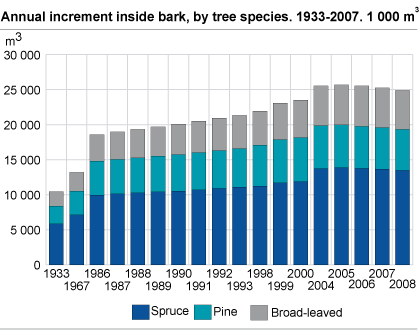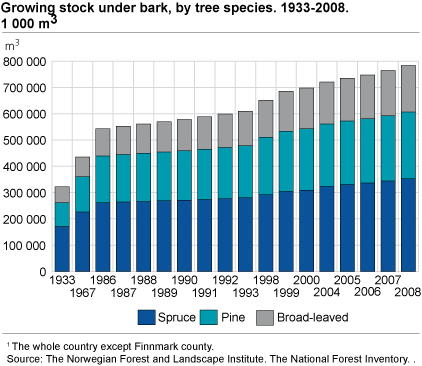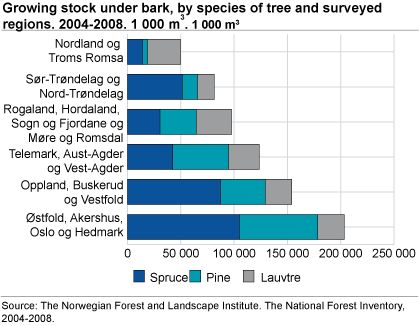Content
Published:
This is an archived release.
More and more wood in Norwegian forests
The volume of growing stock continues to increase. According to calculations from the National Forest Inventory, the volume has increased by 19 million cubic metres from 2007. The total growing stock in Norwegian forests is now 784 million cubic metres.
Out of the total growing stock, 725 million cubic metres stand on the productive forest area. The annual increment in productive forest amounted to 23.6 million cubic metres in 2008, while the annual increment in total was almost 25 million cubic metres. The increment decreased slightly for the third year in a row.
More broad-leaved
Spruce is the most common species of tree with 45 per cent of growing stock, followed by pine with 32 per cent and broad-leaved with 23 per cent. During the last 40 years, the spruce stock has increased by 56 per cent, pine by 90 per cent and the broad-leaved by 136 per cent. In total, the growing stock is 80 per cent higher than 40 years ago.
More spruce in Western Norway
Spruce was most common in the counties of Sør-Trøndelag and Nord-Trøndelag and represented 63 per cent of the volume of growing stock in these counties. In the well forested counties in the eastern part of Norway, spruce also amounted to more than half of the volume. In the northern part of Norway, broad-leaved was most common with 62 per cent of the volume of growing stock. In the western parts of the country, the growing stock was the same level as for spruce, pine and broad-leaved. Fifteen years ago, spruce corresponded to a quarter of the total volume.
Highest occurrence of dead wood in Telemark and Agder
Habitats for vulnerable and endangered species in forest are registered in the same way as for ordinary forest management planning. For the country as a whole, dead wood lying is the most common of these habitats and was found on 12.7 per cent of the productive forest area. The forest region with the counties of Hedmark, Østfold, Oslo and Akershus had the lowest occurrence of dead wood lying with 6.2 per cent. On the other hand, the counties of Telemark, Aust-Agder and Vest-Agder had the highest occurrence with 18.5 per cent.
The productive forest area below the coniferous forest line, excluding Finnmark county, is estimated to be 74 148 square kilometres. In addition, 17 100 square kilometres is considered as unproductive forest area. The total area of wooded land is approximately 120 000 square kilometres.
Tables:
- Table 1 Growing stock inside bark and annual increment inside bark. The whole country. 1933-2008. 1 000 m
- Table 2 Total area, by type of vegetation and surveyed regions. 2000-2004. km
- Table 3 Productive forest area, by development class. The National Forest Inventory. 1 000 hectares and per cent
- Table 4 Growing stock under bark, by type of land, tree species and surveyed regions. 2004-2008. 1 000 m3
- Table 5 Annual increment under bark, by type of land, tree species and surveyed regions. 2004-2008. 1 000 m
- Table 6 Registered incidence of different habitats in productive forest, by region. 2004-2008. Hectares and per cent
Contact
-
Trond Amund Steinset
E-mail: trond.amund.steinset@ssb.no
tel.: (+47) 40 81 13 73



